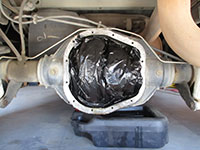Sterling 10.50 Axle Specs
| Manufacturer | Ford Motor Company | |
| Production Plant | Sterling Axle Plant, Sterling, Michigan | |
| Applications | 1999 - current Ford Super Duty | |
| Type | Full floating rear differential | |
| Ring Gear Diameter | 10.50 inches | |
| Pinion Shaft Spline | 31 spline | |
| Axle Tube Diameter | 3.50 inches | |
| Axle Shaft Diameter | 1.50 inches | |
| Axle Shaft Spline | 35 spline | |
| Fluid Spec | SAE 75W-140 synthetic gear oil A friction modifier may be required for limited slip differentials |
|
| Fluid Capacity | 3.25 - 3.50 quarts, always add fluid to fill plug level | |
| Service Intervals | 1999 - 2007 | 100,000 miles (normal conditions) 30,000 miles (severe service conditions, i.e. towing) |
| 2008+ | 100,000 miles (normal conditions) 50,000 miles (severe service conditions, i.e. towing) |
|
| Differential Cover Bolt Torque | 29 - 39 ft-lbs | |
Sterling 10.50 Differential Service Parts List
| Part Description | Part Number(s) | Remarks/Notes |
| Gear oil | 75W-140 full synthetic Recommend Amsoil Severe Gear 75W-140 |
[1] |
| Friction modifier | Motorcraft XL-3 | [2] |
| Differential cover gasket | Dana Spicer RD51999 | [3] |
[1] Any full synthetic 75W-140 gear oil will suffice; recommend Amsoil gear oil.
[2] Required for limited slip differentials.
[3] Gasket optional; differential cover may be sealed with RTV silicon only.
Sterling 10.50 Differential Fluid Replacement Procedures
Ford recommends replacing the differential oil at 100,000 miles under normal driving conditions, 30,000 miles for 1999 - 2007 model year trucks meeting severe service criteria, and 50,000 miles for 2008 and newer model year trucks meeting severe service criteria. Differential fluid should be replaced immediately if an axle is submerged in water as infiltration is highly likely.
Click any thumbnail to view fullsize, detailed image
• Ensure the transmission is set to Park (or in-gear on manual transmissions) and that the parking brake is fully engaged.
• Lower and remove the spare tire and set aside.
• Locate and loosen the fill plug using a 3/8" square drive. It is located on the driver side of the differential housing near the input shaft. The fill plug does not need to be removed at this time, however making sure that the fill plug is not seized before draining the fluid is a good practice.
• Place a suitable drain pan below the differential housing.
• Loosen (2) of the top differential cover bolts halfway, but don't remove them. Remove the remaining (10) bolts using a 1/2" socket.
• Carefully pry the differential housing cover using a razor knife, gasket scraper, putty knife, or thin flathead screwdriver until the silicon seal is broken and the oil begins to drain. Be cautious not to bend/damage the differential cover. The (2) top bolts left in place will keep the cover from splashing into the oil drain container.
• Allow the majority of the differential oil to drain, then remove the remaining differential cover bolts followed by the cover itself.
• Thoroughly clean the differential cover. All remnants of gasket material, silicon, oil, debris, and contaminants must be removed before it can be reinstalled.
• Wrap the differential carrier and ring gear assembly with a large plastic garbage bag.
• Thoroughly clean the differential housing sealing surface. All remnants of gasket material, silicon, oil, debris, dirt, and contaminants must be removed before the cover can be reinstalled. Use brake cleaner or a similar solvent on a clean, lint free rag to remove residual oil from the mounting surface and ensure a positive seal when the cover is reinstalled.
• Run a moderately sized bead (~1/4") of RTV silicon around the sealing surface of the differential cover (recommend Permatex 82180).
Note - a gasket may be used but is not required for this application. 10.50" differentials do not come factory installed with a gasket and only use silicon. We recommend using a gasket. If using a gasket, carefully install it onto the differential cover and, if desired, apply a light bead of silicon on the second side.
• Carefully reinstall the differential cover and all (12) bolts. Snug bolts down in a star or criss-cross pattern. Torque differential cover bolts to 29 to 39 lb-ft.
• Allow the differential cover sealant to cure per the manufacturer's specifications (generally 24 hours).
• Remove the fill plug and use a hand pump to add gear oil to the differential housing until it reaches the fill plug level. When the level is full, oil will begin to run out of the fill plug. Do not rely on the listed oil capacity; always add gear oil until it begins to run out of the fill plug.
Note - Limited slip differentials may require a friction modifier; use Ford/Motorcraft XL-3 (8 oz).
• Reinstall the fill plug and tighten snug.
• Drive vehicle so that the differential fluid reaches operating temperature, then park and check for leaks.








